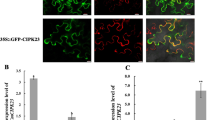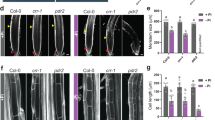Abstract
In Arabidopsis the plasma membrane nitrate transceptor (transporter/receptor) NRT1.1 governs many physiological and developmental responses to nitrate. Alongside facilitating nitrate uptake, NRT1.1 regulates the expression levels of many nitrate assimilation pathway genes, modulates root system architecture, relieves seed dormancy and protects plants from ammonium toxicity. Here, we assess the functional and phenotypic consequences of point mutations in two key residues of NRT1.1 (P492 and T101). We show that the point mutations differentially affect several of the NRT1.1-dependent responses to nitrate, namely the repression of lateral root development at low nitrate concentrations, and the short-term upregulation of the nitrate-uptake gene NRT2.1, and its longer-term downregulation, at high nitrate concentrations. We also show that these mutations have differential effects on genome-wide gene expression. Our findings indicate that NRT1.1 activates four separate signalling mechanisms, which have independent structural bases in the protein. In particular, we present evidence to suggest that the phosphorylated and non-phosphorylated forms of NRT1.1 at T101 have distinct signalling functions, and that the nitrate-dependent regulation of root development depends on the phosphorylated form. Our findings add to the evidence that NRT1.1 is able to trigger independent signalling pathways in Arabidopsis in response to different environmental conditions.
This is a preview of subscription content, access via your institution
Access options
Subscribe to this journal
Receive 12 digital issues and online access to articles
$119.00 per year
only $9.92 per issue
Buy this article
- Purchase on Springer Link
- Instant access to full article PDF
Prices may be subject to local taxes which are calculated during checkout






Similar content being viewed by others
References
Schachtman, D. P. Recent advances in nutrient sensing and signaling. Mol. Plant 5, 1170–1172 (2012).
Nacry, P., Bouguyon, E. & Gojon, A. Nitrogen acquisition by roots: physiological and developmental mechanisms ensuring plant adaptation to a fluctuating resource. Plant Soil 370, 1–29 (2013).
Little, D. Y. et al. The putative high-affinity nitrate transporter NRT2.1 represses lateral root initiation in response to nutritional cues. Proc. Natl Acad. Sci. USA 102, 13693–13698 (2005).
Gojon, A., Nacry, P. & Davidian, J-C. Root uptake regulation: a central process for NPS homeostasis in plants. Curr. Opin. Plant Biol. 12, 328–338 (2009).
Bouguyon, E., Gojon, A. & Nacry, P. Nitrate sensing and signaling in plants. Semin. Cell Dev. Biol. 23, 648–654 (2012).
Wang, Y-Y., Hsu, P-K. & Tsay, Y-F. Uptake, allocation and signaling of nitrate. Trends Plant Sci. 17, 458–467 (2012).
Walch-Liu, P. & Forde, B. G. Nitrate signalling mediated by the NRT1.1 nitrate transporter antagonises l-glutamate-induced changes in root architecture. Plant J. 54, 820–828 (2008).
Gojon, A. et al. Nitrate transceptor(s) in plants. J. Exp. Bot. 62, 2299–2308 (2011).
Gutierrez, R. A. Systems biology for enhanced plant nitrogen nutrition. Science 336, 1673–1675 (2012).
Léran, S. et al. A unified nomenclature of NITRATE TRANSPORTER 1/PEPTIDE TRANSPORTER family members in plants. Trends Plant Sci. 19, 5–9 (2014).
Tsay, Y-F. et al. The herbicide sensitivity gene CHL1 of Arabidopsis encodes a nitrate-inducible nitrate transporter. Cell 72, 705–713 (1993).
Léran, S. et al. The Arabidopsis NRT1.1 is a bidirectional transporter involved in root to shoot nitrate translocation. Mol. Plant 6, 1984–1987 (2013).
Munos, S. et al. Transcript profiling in the chl1–5 mutant of Arabidopsis reveals a role of the nitrate transporter NRT1.1 in the regulation of another nitrate transporter, NRT2.1. Plant Cell 16, 2433–2447 (2004).
Ho, C-H. et al. CHL1 functions as a nitrate sensor in plants. Cell 138, 1184–1194 (2009).
Wang, R. et al. A genetic screen for nitrate regulatory mutants captures the transporter gene NRT1.1. Plant Physiol. 151, 472–478 (2009).
Krouk, G., Tillard, P. & Gojon, A. Regulation of the high-affinity NO3− uptake system by NRT1.1-mediated NO3− demand signaling in Arabidopsis. Plant Physiol. 142, 1075–1086 (2006).
Remans, T. et al. The Arabidopsis NRT1.1 transporter participates in the signaling pathway triggering root colonization of nitrate-rich patches. Proc. Natl Acad. Sci. USA 103, 19206–19211 (2006).
Mounier, E. et al. Auxin-mediated nitrate signalling by NRT1.1 participates in the adaptive response of Arabidopsis root architecture to the spatial heterogeneity of nitrate availability. Plant Cell Environ. 37, 162–174 (2014).
Krouk, G. et al. Nitrate-regulated auxin transport by NRT1.1 defines a mechanism for nutrient sensing in plants. Dev. Cell 18, 927–937 (2010).
Benková, E. et al. Local, efflux-dependent auxin gradients as a common module for plant organ formation. Cell 115, 591–602 (2003).
Simon, S. et al. Defining the selectivity of processes along the auxin response chain: a study using auxin analogues. New Phytol. 200, 1034–1048 (2013).
Liu, K. H. & Tsay, Y-F. Switching between the two action modes of the dual-affinity nitrate transporter CHL1 by phosphorylation. EMBO J. 22, 1005–1013 (2003).
Rubin, G. et al. Members of the LBD family of transcription factors repress anthocyanin synthesis and affect additional nitrogen responses in Arabidopsis. Plant Cell 21, 3567–3584 (2009).
Wang, R. et al. Genomic analysis of the nitrate response using a nitrate reductase-null mutant of Arabidopsis. Plant Physiol. 136, 2512–2522 (2004).
Nemhauser, J. L., Hong, F. & Chory, J. Different plant hormones regulate similar processes through largely nonoverlapping transcriptional responses. Cell 126, 467–475 (2006).
Parker, J. L. & Newstead, S. Molecular basis of nitrate uptake by the plant nitrate transporter NRT1.1. Nature 507, 68–72 (2014).
Sun, J. et al. Crystal structure of the plant dual-affinity nitrate transporter NRT1.1. Nature 507, 73–77 (2014).
Holsbeeks, I. et al. The eukaryotic plasma membrane as a nutrient-sensing device. Trends Biochem. Sci. 29, 556–564 (2004).
Van Nuland, A. et al. Ammonium permease-based sensing mechanism for rapid activation of the protein kinase A pathway in yeast. Mol. Microbiol. 59, 1485–1505 (2006).
Lorenz, E. & Heitman, J. The MEP2 ammonium permease regulates pseudohyphal differentiation in Saccharomyces cerevisiae. EMBO J. 17, 1236–1247 (1998).
Ottenschlager, I. et al. Gravity-regulated differential auxin transport from columella to lateral root cap cells. Proc. Natl Acad Sci. USA 100, 2987–2991 (2003).
Petrášek, J. et al. Do phytotropins inhibit auxin efflux by impairing vesicle traffic? Plant Physiol. 131, 254–263 (2003).
Acknowledgements
This work was supported by the Institut National de la Recherche Agronomique (CJS PhD Fellowship to S.L. & Projet Département BAP, BAP2013-33-NITSE to B.L.), Agence Nationale de la Recherche (ANR-11-JSV6-002-01-NUTSE to B.L.), The Agropolis Foundation (RHIZOPOLIS project to A.G., E.G. and P.N.), the Région Languedoc-Roussillon (Chercheur d'Avenir to B.L.), the Grant Agency of the Czech Republic (GAP305/11/0797 to E.Z.) and the Knowledge Biobase Economy European project (KBBE-005-002 Root enhancement for crop improvement to M.P. and P.N.). The authors thank Jan Petrášek and Alexandre Martiniere-Delaunay for the help with analysis of confocal images, Véronique Santoni for sharing data on NRT1.1 phosphorylation, Gloria M. Coruzzi for providing access to transcriptome facilities and hosting E.B., Amy Marshall Colon for the help with transcriptome analyses and Nigel M. Crawford for critical reading and editing of the manuscript.
Author information
Authors and Affiliations
Contributions
E.B., F.B., M.K., D.M., M.P., S.L., K.H. and P.N. performed experimental work; E.B., M.K., B.L., G.K., K.H., P.N. and A.G. performed data analysis; E.B., E.G., E.Z., P.N. and A.G. oversaw project planning; E.B., G.K., K.H., P.N. and A.G. wrote the paper.
Corresponding author
Ethics declarations
Competing interests
The authors declare no competing financial interests.
Supplementary information
Rights and permissions
About this article
Cite this article
Bouguyon, E., Brun, F., Meynard, D. et al. Multiple mechanisms of nitrate sensing by Arabidopsis nitrate transceptor NRT1.1. Nature Plants 1, 15015 (2015). https://doi.org/10.1038/nplants.2015.15
Received:
Accepted:
Published:
DOI: https://doi.org/10.1038/nplants.2015.15
This article is cited by
-
Toxic effects of lead on plants: integrating multi-omics with bioinformatics to develop Pb-tolerant crops
Planta (2024)
-
Genome-wide identification and expression analysis of the NRT genes in Ginkgo biloba under nitrate treatment reveal the potential roles during calluses browning
BMC Genomics (2023)
-
Pseudomonas aeruginosa LasI-dependent plant growth promotion requires the host nitrate transceptor AtNRT1.1/CHL1 and the nitrate reductases NIA1 and NIA2
Planta (2023)
-
Balancing nitrate acquisition strategies in symbiotic legumes
Planta (2023)
-
New insights into the role of chrysanthemum calcineurin B–like interacting protein kinase CmCIPK23 in nitrate signaling in Arabidopsis roots
Scientific Reports (2022)



